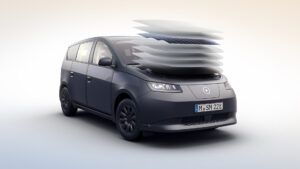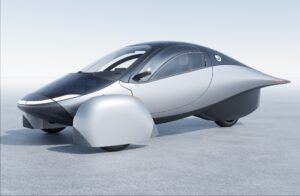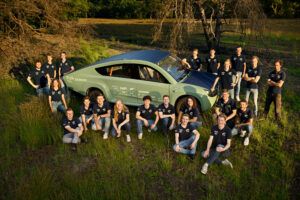The complicated harnessing of photo voltaic power to energy electrical automobiles continues to be comparatively untapped, however new options are being launched to make it a extra inexpensive and mainstream expertise. However are vehicles powered by the rays of the solar actually the way forward for mobility?
 Proper now, solar-power electrical automobile expertise stays a minority innovation, primarily as a result of concerned nature of power seize and energy switch. However there are lots of folks on the market who imagine it gained’t at all times be that manner.
Proper now, solar-power electrical automobile expertise stays a minority innovation, primarily as a result of concerned nature of power seize and energy switch. However there are lots of folks on the market who imagine it gained’t at all times be that manner.
A kind of folks is Jan Schiermeister, VP expertise at Sono Motors, though growing the expertise for on a regular basis use will not be with out its setbacks. Sono Motors had been growing the Sion, a solar-powered EV with monocrystalline silicon cells built-in into its physique however needed to terminate this system in early 2023. That initiative was meant on the market, so Sono Motors’ focus is now on business-to-business photo voltaic options, retrofitting and integrating its photo voltaic expertise onto third occasion automobiles. A complete of 25 prospects – together with Scania, Kögel and Chereau – are piloting its scalable photo voltaic expertise on quite a lot of automobile architectures.
“We’ve got been working for years to appreciate polymer sandwich vehicle-integrated photo voltaic modules that may be made in nearly each three-dimensional form,” says Schiermeister. “The modules will be utilized on automobile sides, tailgate or hood, not solely on the roof, fulfilling necessities for the PV and automotive sectors,” he says. “Though identified photovoltaic (PV) modules aren’t designed for static use instances and particularly not for automotive necessities, in regard to authorized complexities akin to crash habits or flammability.”
Due to this, implementation of automobile physique photo voltaic cells is a problem, as strict occupant security and pedestrian safety necessities should be met. “Shut cooperation with automobile OEMs is required and retrofitting is harder,” says Georg Zurmühl, Sono Motors’ product supervisor. “Nonetheless, our automobile built-in photovoltaic (VIPV) expertise based mostly on automotive molding processes is exclusive, unlocking the potential for 3D-shaped photo voltaic physique panels.” Zurmühl provides that the excessive quantity manufacture, low cycle occasions and affordable prices are key advantages.
“You may’t have photo voltaic with out effectivity,” says Steve Fambro, co-founder and co-CEO of US photo voltaic EV start-up Aptera Motors. “The pursuit of effectivity first lets us do issues akin to photo voltaic mobility. However the expertise must be cell in addition to dependable, which provides a further layer of software. In case you took a photo voltaic panel and electronics IP we have already got and put it on an everyday automobile, it gained’t have any considerable affect.” Which is why Fambro believes a ground-up strategy is the very best resolution to leverage the expertise.
He explains that the sky-facing surfaces on the physique of Aptera’s first photo voltaic EV are clothed in photo voltaic polymer sandwich panels that use a proprietary expertise, which encapsulates the photo voltaic cell itself to guard it in opposition to moisture and oxygen. Aptera has patents for using glass or plastic for the entrance and rear panel surfaces, and both materials can be utilized relying on the appliance. “It additionally must be light-weight and has to supply energy when unfold throughout the automobile when a part of it’s shaded or coated,” says Fambro. “Creating curved photo voltaic panels for automobiles which might be light-weight sufficient to fabricate whereas in a position to face up to hail strikes, vibration and thermal biking, has been the principle focus of our IP.”
As much as 700 watts of steady charging energy is launched by Aptera’s photo voltaic panels, sufficient for as much as 40 miles of vary per day. Over the course of a 12 months, Fambro believes a location akin to San Diego has the potential to seize as a lot as 11,000 miles’ value of photo voltaic power – 4kWh per day. Batteries of 25, 40, 60 or 100kWh are mooted, utilizing Lithium Nickel-Cobalt-Aluminum Oxide (NCA) chemistry, and EVE Vitality Co’s 21700 NMC 811 cylindrical cells. The Launch Version automobile can have the 40kWh battery – truly 42kWh usable, 45kWh gross capability – with as much as 400 miles of vary and a projected effectivity goal of as much as 10mpkWh (100Wh/mile). Liquid-cooling allows dependable 40-60kW NACS quick charging.
 Rays of hope
Rays of hope
With a historical past in growth of solar-powered EVs, a staff from the Eindhoven College of Expertise has not too long ago accomplished in depth testing in Morocco of the street authorized Stella Terra, a solar-powered off-road EV with the potential to journey 390 miles on a sunny day. Niels van den Broek, a Photo voltaic Staff Eindhoven electrical engineer, says common photo voltaic panels couldn’t be used, as they might compromise aerodynamics and add pointless weight. “We opted for versatile panels – consisting of a generally used plastic front and back sheet, housing the photo voltaic cells with adhesive in-between – that could possibly be positioned on our single-curved bonnet and roof,” he says. “The photo voltaic cells are comparatively normal, with a excessive effectivity of 23.7%. Employed in home photo voltaic panels, our undertaking exhibits even with ‘regular’ photo voltaic cells, it’s possible to make a automobile absolutely powered by the solar.”
Whereas specialist expertise will not be at all times important, a extra proprietary strategy is healthier in a position to make use of photo voltaic power in more and more concentrated methods. Schiermeister explains Sono’s distinctive microcontroller or digital management unit (MCU) has each a excessive effectivity and high-voltage capabilities, enabling a extremely environment friendly photo voltaic yield whereas driving. “Our energy electronics is a specifically designed multi-channel idea, combining a number of most energy level trackers (MPPTs) in a single field. This enables for each environment friendly and unbiased operation of a number of photo voltaic modules with completely different orientations in direction of the solar. It adapts tremendous rapidly to fast-changing solar radiation situations, key for cell photo voltaic functions the place each harvested Wh is effective,” Schiermeister elaborates.
Van den Broek explains Photo voltaic Staff Eindhoven’s greatest problem was the absence of a 400V MPPT. “With out an MPPT, photo voltaic panels on a automobile can be much less efficient and even ineffective. In Stella Terra, the battery voltage varies between 280 to 400V, relying on the state of cost (SoC). Nonetheless, the voltage output of our photo voltaic teams varies between 50-90V. This means an influence converter needs to be positioned between the photo voltaic teams and our HV system; in any other case, the present generated by the photo voltaic panels is not going to move into the battery. Consider it like water; water solely flows from a better level to a decrease level – present solely flows from greater present to decrease present,” he says.
One other impediment in making a solar-powered automobile is the relative contribution of solar energy to the whole energy utilized by the automobile itself. “Putting a number of photo voltaic panels on a automobile might solely produce sufficient power for a small share of the whole power utilization,” says Van den Broek. “Our purpose was to create a solar-powered automobile that might drive solely on photo voltaic power. This required vital effort to design a light-weight and aerodynamic automobile that consumes as little power as attainable.”
A light-weight construction not solely advantages effectivity, but additionally the photo voltaic power expertise itself. Aptera makes use of a type of carbon composite with a really excessive fee of manufacturing. Impressed by plane with a low frontal space and small cross-section, the automobile has a teardrop form and an aluminum stomach pan. Two entrance wheels and one rear wheel support the projected effectivity. “There’s one much less wheel so there’s a major quantity of construction that’s not wanted to help a fourth quarter,” Fambro explains. A low drag coefficient of 0.13 means the Aptera’s physique is as optimized as it may be, too.
Additional efficiencies will be made by means of using direct-drive powertrains. “Taking a look at how effectivity stacks up, in-wheel motors are the subsequent step,” says Fambro. Aptera has been working with direct drive powertrain specialist Elaphe to co-design its present motor, which is a spinoff of what the corporate produces. “Nonetheless, it has been redesigned to be absolutely the most effective in our energy regime, for torque, rpm and typical loading,” says Fambro. With an eye fixed on even additional efficiencies, silicon carbide inverter expertise can also be being evaluated.
 Right here comes the solar
Right here comes the solar
In-wheel motors from Protean have been chosen for the Stella Terra. “In-hub motors remove the necessity for drive shafts, enhancing aerodynamics,” says says Van den Broek. “Protean motors even have as much as 93% effectivity, encompassing motor and inverter, and have the very best IP-rating attainable. In addition they adhere to the ISO26262 purposeful security normal, instilling confidence of their reliability. Housing the motor and inverter in a single unit considerably eased incorporation of the motors into the Stella Terra’s electrical structure.” A 16-strong staff started growth of the Stella Terra in September 2022. A 12 months later, with an expanded staff of twenty-two, the off-road automobile was introduced in its closing kind. Assessments on the power utilization of various off-road surfaces offered beneficial insights, guaranteeing the EV may full its difficult 620-mile (1,000km) tour solely on solar energy.
Attributable to their excessive power demand used for customers akin to infotainment screens, HVAC programs, and repeated door opening and shutting features, buses and supply service automobiles presently seem to profit essentially the most from photo voltaic expertise. “Diesel buses burn gasoline for these features and profit enormously if this gasoline is changed by solar energy,” says Zurmühl. “E-buses and cooled items supply automobiles lose driving vary because the battery has to energy the customers, and because of this photo voltaic integration is so helpful.” Photo voltaic additionally advantages hybrid automobile functions, however the positive factors are much less marked and rely upon particular person utilization instances.
To see solar-powered EV expertise grow to be extra widespread, Fambro believes {that a} mass adoption by trade could be wanted, accompanied by extra environment friendly platforms. “That comes again to the ground-up strategy, which actually must be a ground-up rethink of what environment friendly transportation seems like,” he says, believing different low pace mobility markets away from the passenger automobile sector have extra available alternatives.
Van den Broek thinks that each EV sector can profit from photo voltaic expertise, however that photo voltaic integration does come at a price, and a return on funding is predicted. “Moreover, there are geographical variations, with some areas having larger solar energy manufacturing potential than others,” he says. It is because of this Van den Broek views photo voltaic integration primarily, for now, as a supplemental choice.
But Schiermeister feels all sectors the place there’s adequate consumption of power and the price of power and vary performs a job will profit. “Brief time period, industrial automobiles akin to buses and refrigerated automobiles will profit as they’ve a further excessive power demand over the excessive power demand for driving,” he says. “As they’ve enormous surfaces that may be coated with photo voltaic panels, the implementation is comparatively straightforward.” Whereas believes that within the mid-term, integration into passenger automobile physique panels will profit this sector, unlocking enormous potential for greater photo voltaic power yields per automobile, Schiermeister concedes that photo voltaic might at all times be an add-on. “It’s going to enrich conventional EVs and never problem them. OEMs might supply non-compulsory photo voltaic options, however with growing efficiencies and sinking prices of photo voltaic cells and since power from the solar is free – after the preliminary funding, photo voltaic integration has the potential to grow to be a broad EV software.”
Fambro says first Aptera deliveries are projected to reach 9 to 12 months after the closure of the corporate’s main funding spherical which presently stays open, however how far into the longer term will photo voltaic expertise begin to problem extra conventional EV functions? “We try to remain 5-10 years forward of the market, demanding specialist expertise for our photo voltaic integration,” says Van den Broek. “Our imaginative and prescient is that inside 10 years, most automobile firms will supply an choice to combine photo voltaic panels on sure fashions, with an growing variety of automobiles actively utilizing photo voltaic panels to cost their batteries.”


